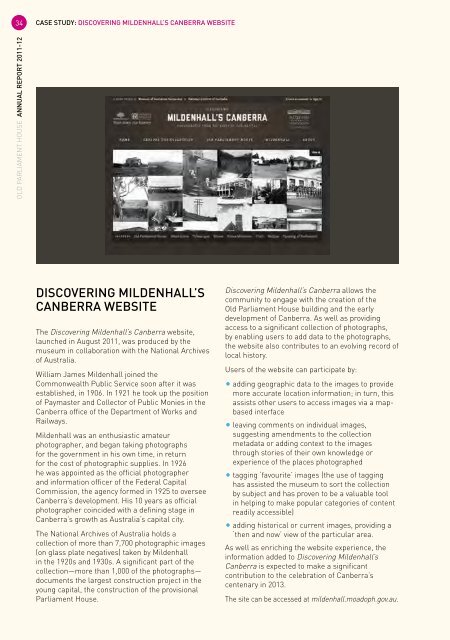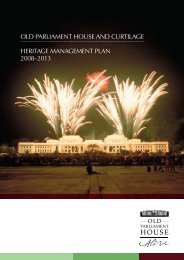OLD PARLIAMENT HOUSE ANNUAL REPORT
Annual Report - Museum of Australian Democracy at Old Parliament ...
Annual Report - Museum of Australian Democracy at Old Parliament ...
- No tags were found...
You also want an ePaper? Increase the reach of your titles
YUMPU automatically turns print PDFs into web optimized ePapers that Google loves.
34<br />
<strong>REPORT</strong> CASE STUDY: ON PERFORMANCE<br />
DISCOVERING MILDENHALL’S CANBERRA WEBSITE<br />
<strong>OLD</strong> <strong>PARLIAMENT</strong> <strong>HOUSE</strong> <strong>ANNUAL</strong> <strong>REPORT</strong> 2011-12<br />
DISCOVERING MILDENHALL’S<br />
CANBERRA WEBSITE<br />
The Discovering Mildenhall’s Canberra website,<br />
launched in August 2011, was produced by the<br />
museum in collaboration with the National Archives<br />
of Australia.<br />
William James Mildenhall joined the<br />
Commonwealth Public Service soon after it was<br />
established, in 1906. In 1921 he took up the position<br />
of Paymaster and Collector of Public Monies in the<br />
Canberra office of the Department of Works and<br />
Railways.<br />
Mildenhall was an enthusiastic amateur<br />
photographer, and began taking photographs<br />
for the government in his own time, in return<br />
for the cost of photographic supplies. In 1926<br />
he was appointed as the official photographer<br />
and information officer of the Federal Capital<br />
Commission, the agency formed in 1925 to oversee<br />
Canberra’s development. His 10 years as official<br />
photographer coincided with a defining stage in<br />
Canberra’s growth as Australia’s capital city.<br />
The National Archives of Australia holds a<br />
collection of more than 7,700 photographic images<br />
(on glass plate negatives) taken by Mildenhall<br />
in the 1920s and 1930s. A significant part of the<br />
collection—more than 1,000 of the photographs—<br />
documents the largest construction project in the<br />
young capital, the construction of the provisional<br />
Parliament House.<br />
Discovering Mildenhall’s Canberra allows the<br />
community to engage with the creation of the<br />
Old Parliament House building and the early<br />
development of Canberra. As well as providing<br />
access to a significant collection of photographs,<br />
by enabling users to add data to the photographs,<br />
the website also contributes to an evolving record of<br />
local history.<br />
Users of the website can participate by:<br />
• adding geographic data to the images to provide<br />
more accurate location information; in turn, this<br />
assists other users to access images via a mapbased<br />
interface<br />
• leaving comments on individual images,<br />
suggesting amendments to the collection<br />
metadata or adding context to the images<br />
through stories of their own knowledge or<br />
experience of the places photographed<br />
• tagging ‘favourite’ images (the use of tagging<br />
has assisted the museum to sort the collection<br />
by subject and has proven to be a valuable tool<br />
in helping to make popular categories of content<br />
readily accessible)<br />
• adding historical or current images, providing a<br />
‘then and now’ view of the particular area.<br />
As well as enriching the website experience, the<br />
information added to Discovering Mildenhall’s<br />
Canberra is expected to make a significant<br />
contribution to the celebration of Canberra’s<br />
centenary in 2013.<br />
The site can be accessed at mildenhall.moadoph.gov.au.




